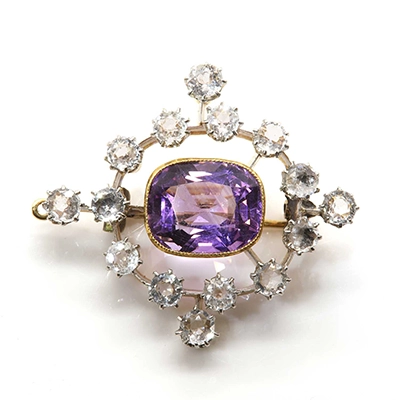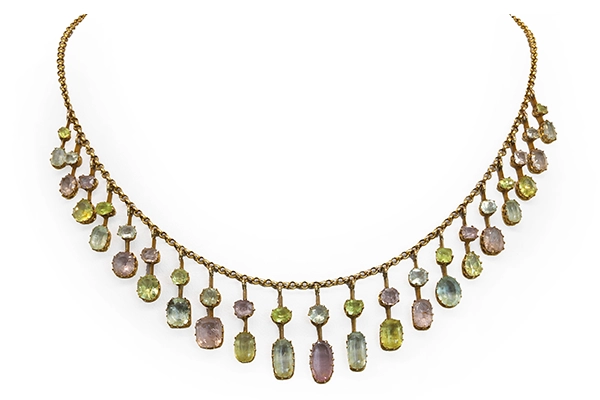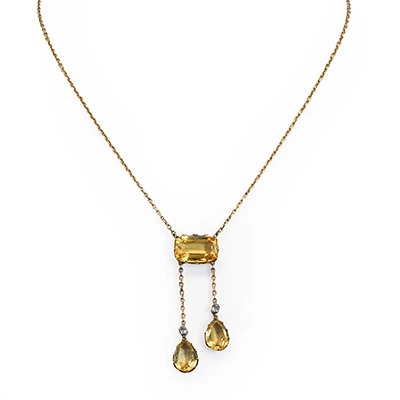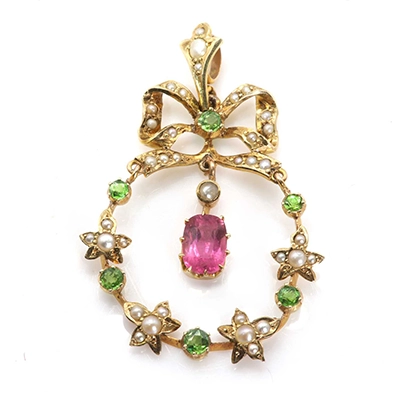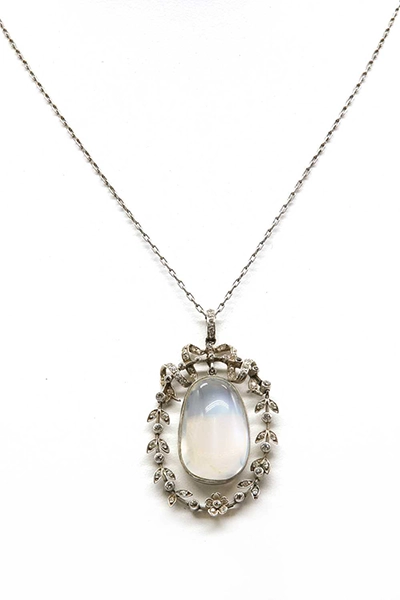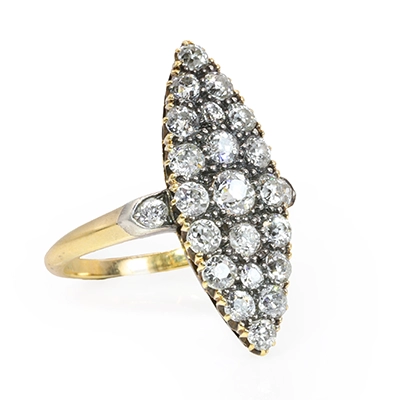18 April 2024
The frivolous and fancy world of Edwardian jewellery
7 minutes
During King Edward VII’s short reign, 1902-1910, exciting new jewellery designs saw heavier Victorian jewellery make way for softer styles that remain wearable today, says Sworders jewellery specialist Valeria Di Cola
What’s not to love about Edwardian jewellery? It’s lighter and more frivolous than earlier Victorian styles, with beautiful pastel-coloured gemstones – amethyst, pink and yellow topaz, tourmaline – as well as opals, pearls and diamonds. The pieces remain affordable and, importantly, still very wearable. I love to wear this jewellery that women in society once wore in layers to demonstrate their wealth and rank.
It was a time of great change with many technological advances including the installation of electricity into homes of those who could afford it. This made Victorian clothes and furnishings that had looked rich in candlelight seem dull under electric lights.
The Edwardians began to favour pastels and softer styles. King Edward and Queen Alexandra’s influence on high society fashion had actually started long before they reigned; they were the accepted leaders of society from the 1880s, after Queen Victoria had withdrawn to mourn her late husband Prince Albert.
Edwardians were the first to embrace platinum after new deposits were discovered around 1880 in the Ural Mountains, in Siberia. In turn, advancements in engineering allowed jewellers’ torches to reach the melting point of platinum. Diamonds were also in plentiful supply as South African diamonds had been pouring into Europe since the 1880s.
Platinum was perfectly suited to the popular Edwardian garland designs, allowing small diamond accents to be set and held in delicate frames. These garland motifs such as scrolls, tassels, foliage, flowers, ribbons and laurel wreaths with central drops were popular on ‘light and lacy’ brooches and pendants which were, in general, subtle and in good taste.
|
(Image: Edwardian amethyst and white topaz brooch/pendant, estimate £150-250) |
Although there are far fewer Edwardian jewellery pieces to be seen on the market compared to the long 60-year Victorian era there are many interesting styles for look out for:
Fringe necklaces were particularly fashionable and often set with Harlequin vari-coloured gems, while negligee pendant necklaces were in vogue around 1900, made up of fine link drops with two parallel pendants suspended at varying lengths.
At Sworders Fine Jewellery & Watches auction on May 21, 2024 we have several good examples including a pink topaz, aquamarine and chrysolite fringe necklace c.1905 (estimate £800 -£1,200) and a yellow topaz and diamond negligee necklace with an estimate of £300-£500.
|
(Image: Edwardian pink topaz, aquamarine and chrysolite fringe necklace, c.1905) |
(Image: Edwardian yellow topaz and diamond negligee necklace, estimate £300-500) |
From 1900, the Lavalliere, Edna May and negligee pendant necklaces began to be commissioned. The Lavalliere was named after actress Eve Lavalliere, mistress of Louis XIV of France. The necklace was a single gem-cut in a round, oval or pear shape suspended from a chain.
The Edna May, named after the opera singer, was a larger single gem suspended from a smaller single gem or group of gems on a chain.
The negligee necklace featured two large stones suspended at differing lengths from a chain. It was a way to appreciate two wonderful unmatched gems, such as a pearl and a diamond.
An early 20th century split pearl, demantoid garnet and pink tourmaline pendant sold for £910 in our Fine Jewellery & Watches auction in November 2023.
|
(Image: Early 20th century split pearl, demantoid garnet and pink tourmaline pendant, sold for £910 inc buyer’s premium in November 2023.) |
Coloured gemstones
Princess Alexandra loved shades of pale purple so amethysts were her favourite stone and many pieces of jewellery included this gem.
Yellow sapphires, probably from Ceylon (now Sri Lanka) came on the market from 1908. Other favoured gems were King Edward's favourite peridots, rubies from Burma (Myanmar), turquoise from Persia (Iran) and emeralds from Colombia.
|
|
Phenomenal gemstonesThe Edwardians were fascinated by unusual stones. Australian opals were often incorporated into jewellery as well as Mexican fire opal, Ceylonese moonstone and Russian alexandrite. The Ceylonese moonstones, particularly, were prized because they displayed interesting optical effects under varying light conditions. An Edwardian moonstone and diamond galleried pendant, sold for £1,560 in our June 2023 auction. PearlsIt was unusual for an Edwardian woman not to have at least one strand of fine pearls. At her coronation in 1902, Queen Alexandra wore several strands that had belonged to Queen Catherine de Medici, Mary, Queen of Scots and Queen Elizabeth I. In fact, provenance was part of the charm of many pearls sold during this period. American heiress Consuelo Vanderbilt, who became the Duchess of Marlborough, owned pearls that had once belonged to Catherine the Great of Russia and Empress Eugenie of France. (Image: Edwardian moonstone and diamond galleried pendant, sold for £1,560 inc buyer’s premium in June 2023.) |
BroochesBrooches were used to pin layers of lace, tulle and chiffon at the low neckline. Symbolic motifs included swallow and dove, anchors, arrows, daggers, violins and harps. A heart with coronet and bow in garland style was another popular option. An Edwardian amethyst and white topaz brooch/pendant features in Fine Jewellery & Watches auction May 21, 2024 , estimate £150-250. EarringsPearls and diamonds set in platinum as simple drops or studs were the favourite combination although after 1910 there was a fashion for dangling earrings to be worn with evening attire. (Image: Edwardian gold, opal and diamond brooch, sold for £1,170 inc buyers’ premium November 2022.) |
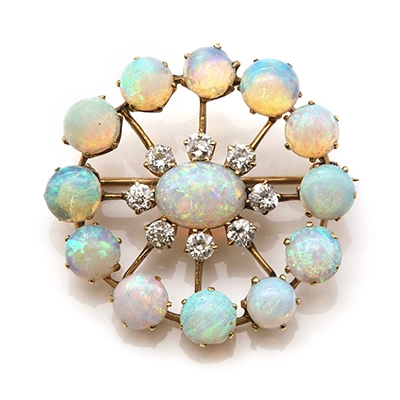 |
|
|
RingsThe popularity of marquise cluster rings continued from the late Victorian era, set with graduating old-cut diamonds. We have an Edwardian diamond marquise form ring, estimate £700 – £900, at our Fine Jewellery & Watches auction on May 21. Men’s jewelleryFormal evening dress comprised of matching dress sets of cuff links, shirt studs and waistcoat buttons and King Edward is known to have owned a dress set, with rubies and diamonds, made by Fabergé. (Image: Edwardian diamond marquise form ring, estimate £700-£900.) |
The end of an era
The luxurious Edwardian lifestyle was shattered by the onset of the First World War when lifestyles changed virtually overnight. Many jewels were locked away or sold but they still come up for auction. Very often these pieces have been handed down for generations and the owner is unaware of the value and collectability. As a jewellery specialist there are a few moments more thrilling than stumbling upon a piece of antique jewellery that hasn’t yet seen the auction floor!
What to look for when buying Edwardian jewellery
- Ensure pieces haven’t undergone repairs or remodelling
- Jewellery in their original fitted cases as they will hold more at value when reselling – and they have been stored properly for generations)
- Original pieces – always buy from a reputable source
- Pearl set jewellery – Edwardian jewellery is the last to feature the use of natural pearls)
If you have a collection to sell or are interested in buying Edwardian jewellery you can contact ValeriaDiCola@sworder.co.uk
About Valeria Di Cola
Valeria is a qualified gemmologist and jewellery specialist with a keen interest in the history and geography of gemstones, and the individuals connected to them. Often found captivated by the inner world of gemstones through her microscope, Valeria’s journey led her from living in Italy to China and then Australia, before settling in London in 2016. In 2023, she joined Sworders auctioneers where she curates the jewellery specialist sales. Valeria holds regular valuation days in Essex and Hertfordshire and loves uncovering hidden treasures within her clients’ jewellery boxes.
How to care for Edwardian jewellery
A jewellery collection is precious both financially and sentimentally – so it’s important to take good care of it.
- Always keep your jewellery in individual velvet pouches or jewellery cases, not allowing them to sit loosely in a jewellery box or drawer together with other pieces of jewellery
- Make sure pearl set pieces are kept away from harsh chemicals
- Occasionally give a gentle clean with warm water and mild detergent, but allow only a professional jeweller to perform deeper cleaning.
- A soft toothbrush can help clean diamond set pieces and gemstones, but care must be taken when handling settings
For more advice read our article: Looking after your jewellery: cleaning tricks to storage tips
Jewellery Insurance
Whether you are a long-term collector or new to buying jewellery, remember the importance of regular valuations. Professional jewellery valuations are vital, especially as market rates for precious metals and stones fluctuate quickly.
Insurers recommend that you obtain a jewellery valuation at least every five years, preferably three in today’s market. But check your schedule and policy wording for specific requirements.
Insurers will require any valuation to be for “insurance purposes” and for retail value. You should also consider how you would replace your jewellery in the event of a loss. Would you want a brand new replacement with a modern equivalent (New Replacement Value), second hand replacement value (which can be more than the retail value if there’s a waiting list for a piece) or would you prefer an antique replacement (Antique Replacement Value)?
Ensure the items are photographed, kept in good condition and your documentation is in a safe place to help in the event of a claim. It’s a good idea to send a copy of your valuations to your broker, whether or not the insurer requires it.
Howden are specialists in finding jewellery insurance solutions, something you should never have to do on your own. We can point you in the direction of trusted valuation experts and then arrange a policy which will protect your passion and investment.
To speak to Howden about insuring your jewellery call 020 8256 4901 or email privateclients@howdeninsurance.co.uk.

